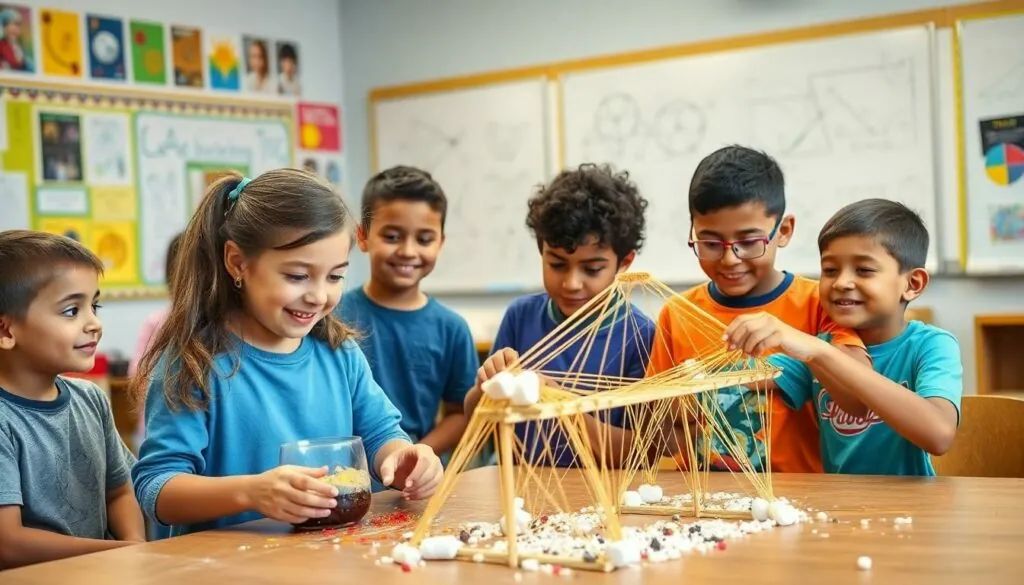Table of Contents
ToggleFifth grade is a magical time when kids are bursting with curiosity and energy. It’s the perfect moment to introduce them to the exciting world of STEM—science, technology, engineering, and math. Why not turn their natural inquisitiveness into hands-on fun? With engaging STEM activities, students can explore concepts while having a blast, proving that learning doesn’t have to be boring.
Imagine your child building a volcano that erupts with a fizzy explosion or designing a bridge that can withstand the weight of their latest LEGO creation. These activities not only spark creativity but also develop critical thinking skills. So, buckle up and get ready to dive into five fantastic STEM activities that will have your fifth grader asking for more—because who knew learning could be this much fun?
Overview of 5th Grade STEM Activities
5th grade STEM activities play a crucial role in enhancing students’ understanding of science, technology, engineering, and mathematics. Engaging projects foster curiosity and allow children to explore essential concepts in interactive ways. Activities such as building erupting volcanoes introduce basic chemical reactions, while designing sturdy bridges incorporates principles of engineering and physics.
Incorporating hands-on tasks enhances critical thinking skills. Students apply theoretical knowledge to real-world problems, boosting their confidence in STEM subjects. Group projects encourage teamwork and communication, developing social skills alongside academic learning.
Teachers can implement various STEM initiatives, ensuring they align with curriculum standards. Simple experiments, like growing crystals or creating circuits, require minimal materials yet yield significant learning experiences. Field trips to science museums or nature centers expand students’ exposure to STEM outside the classroom.
Using technology in these activities also amplifies interest. Coding robots or creating video presentations encourages creativity while reinforcing key concepts. Integrating digital tools into projects can provide students with relevant skills for future careers.
Scheduling regular STEM challenges promotes ongoing engagement. Each week, a new activity can revitalize class dynamics and sustain excitement. Regular assessments can measure understanding and allow educators to tailor tasks to individual needs, ensuring every student thrives.
Overall, 5th grade STEM activities create a rich learning environment, combining education, creativity, and collaboration in ways that inspire young minds.
Benefits of STEM Education
STEM education offers numerous advantages for fifth graders, promoting essential skills through engaging activities.
Enhancing Critical Thinking Skills
Critical thinking skills develop when students engage with hands-on projects. They analyze problems and apply theoretical concepts to find solutions. For example, building a simple bridge requires them to consider weight distribution and materials. Students encounter challenges that invite creative thinking, leading to innovative solutions. Learning through experiments encourages them to hypothesize and test their ideas in real-time. With each project, they gain confidence in their ability to tackle complex issues. This development forms a strong foundation for future problem-solving and analytical skills.
Promoting Teamwork and Collaboration
Teamwork and collaboration flourish in STEM activities. Group projects require students to communicate ideas and delegate tasks effectively. Working together fosters a sense of responsibility and accountability among peers. For instance, designing a model rocket necessitates cooperation, allowing students to pool knowledge and resources. Collaborative experiences build social skills, as students learn to respect diverse viewpoints. These interactions not only enhance their understanding of subjects but also prepare them for future collaborative environments. As they navigate group dynamics, students build friendships and develop a sense of community within the classroom.
Popular 5th Grade STEM Activities
Fifth-grade students benefit significantly from dynamic STEM activities that encourage exploration and creativity. These activities engage students and enhance their understanding of essential concepts.
Hands-On Science Experiments
Incorporating hands-on science experiments captivates students’ attention. Experiments like creating homemade slime introduce concepts such as viscosity and chemical reactions. Another engaging project is growing crystals, which illustrates the process of crystallization and requires minimal materials. Students enjoy experimentation, and it encourages inquiry-based learning. Classifying and recording observations during these activities develops scientific reasoning. These practical experiences ignite curiosity and bolster students’ confidence in the sciences.
Engineering Challenges
Engineering challenges stimulate critical thinking and problem-solving skills. Activities like designing and constructing a bridge using only spaghetti and marshmallows integrate basic engineering principles. Teams work together to test stability and strength, promoting collaboration and communication. Building a model rocket fosters an understanding of aerodynamics and propulsion while encouraging creativity. Each challenge allows for exploration and iteration, where students learn from successful and unsuccessful designs. These projects develop resilience and encourage innovation in young minds.
Incorporating Technology in STEM
Integrating technology in STEM activities enhances student engagement and understanding. Various tools and platforms offer unique experiences that stimulate creativity and critical thinking.
Coding and Robotics
Students grasp coding concepts through hands-on activities. Engaging with robotics, they build and program machines, fostering problem-solving skills. Popular platforms like Scratch provide opportunities for creating interactive stories and games. Challenges like programming a robot to navigate a maze develop logic and sequencing abilities. Incorporating robotics kits, such as LEGO Mindstorms, inspires teamwork as students collaborate on projects. These activities ensure students learn essential programming basics while having fun.
Virtual STEM Projects
Virtual STEM projects expand learning beyond the traditional classroom. Utilizing online resources like simulations and virtual labs, students explore scientific concepts interactively. Websites such as PhET offer simulations that visualize complex principles, from genetics to physics. Team-based challenges, such as designing a sustainable city in Minecraft, merge creativity with environmental education. Moreover, with tools like Google Classroom, educators can assign and monitor projects seamlessly. Integrating these digital experiences deepens understanding and keeps students engaged in STEM learning.
Tips for Implementing STEM Activities
Incorporating STEM activities requires thoughtful planning and execution. Focusing on specific resources and techniques enhances the effectiveness of these learning experiences.
Resources and Materials
Collecting appropriate resources creates a solid foundation for students. Basic supplies often include cardboard, scissors, tape, and glue, which facilitate various projects. Experimenting with readily available materials makes activities accessible. Incorporate tools like tablets or computers for coding exercises. Engaging materials enhance experiments, such as vinegar and baking soda for volcano eruptions or straws and popsicle sticks for engineering challenges. Utilizing local resources, such as nature for outdoor experiments, deepens the learning experience.
Encouraging Student Engagement
Generating excitement in the classroom enhances student participation. Start by allowing students to select projects that resonate with their interests. Observing classmates work together encourages teamwork and collaboration. Creating a welcoming environment promotes creativity and open-mindedness. Encouragement during the learning process makes a difference; praise effort and innovation, regardless of outcomes. Motivating students with fun challenges or competitions maintains momentum and fosters a growth mindset. Accepting a range of ideas from students further cultivates an inclusive atmosphere for discussion and exploration.
Conclusion
5th grade STEM activities are vital for nurturing young learners’ curiosity and creativity. By engaging students in hands-on projects they not only grasp essential concepts but also develop critical thinking and collaboration skills. These activities create an interactive environment that fosters a love for science, technology, engineering, and math.
Implementing thoughtful STEM initiatives can transform the classroom experience. When students actively participate in projects that resonate with their interests they become more invested in their learning journey. This approach not only enhances their understanding of STEM subjects but also prepares them for future challenges in a rapidly evolving world. Embracing these activities will inspire the next generation of innovators and problem solvers.


